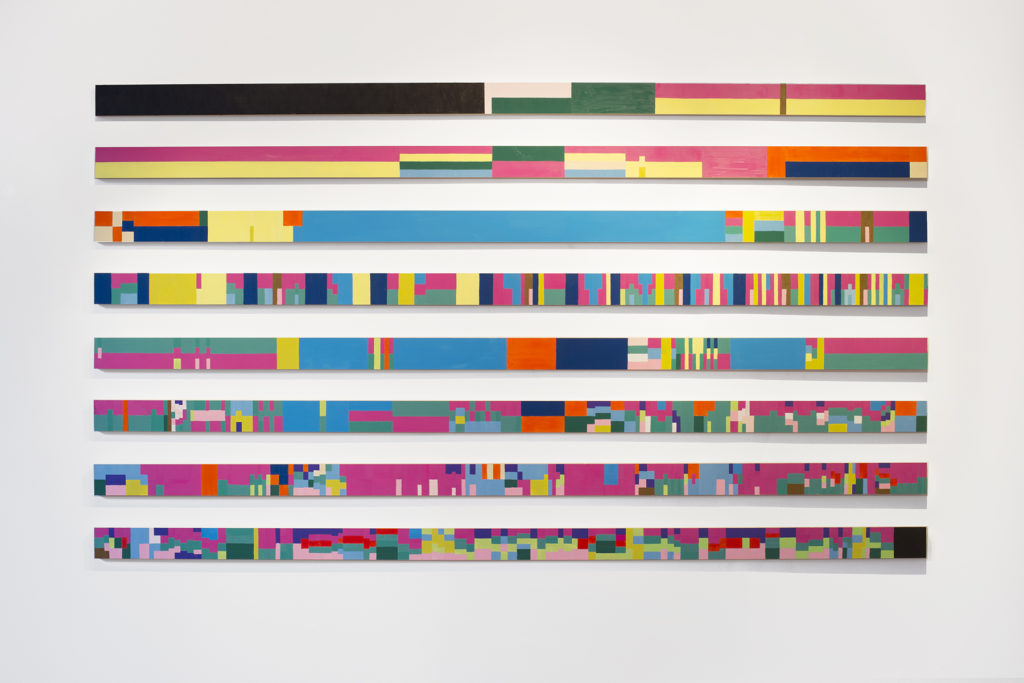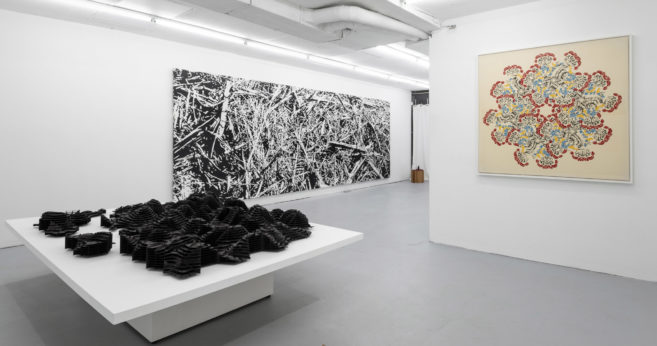On the side of the elevator that takes tourists to the top of Vancouver’s skyline icon, the Harbour Centre, a slogan is visible: “See it all from here.” It is not without a touch of irony that Khan Lee includes the phrase in his watercolour painting Victory Square (all works 2019), which depicts the Harbour Centre’s rooftop, a liminal space between the offices below and the observation decks above. An array of radio antennae rest underneath the lip of the building’s viewing platform, their blank inscrutability a counterweight to the transparency of the windows and sky around them. From the platform, it is impossible to see the antennae below.
Lee’s solo exhibition “Wings of Desire” is parabolic. It speaks to our profound immersion within systems of surveillance and user-control, but refuses to reveal them to us directly, expressing them instead through their superficial traces. Though the works on display are ostensibly themed on the subject of radio waves and the electromagnetic spectrum, they approach these topics at an oblique angle; they are close, but out of reach. Lee’s portrayal of the Harbour Centre rooftop, for example, is part of a series of five realist watercolours in the exhibition that picture various radio arrays from around the Greater Vancouver area with documentarian indifference; isolated against the sky, they evoke alien monoliths, their simple facticity revealing nothing about their origins nor the nature of the messages they convey.
Other works in the exhibition convey a similar absence. They include a series of cast plaster forearms, their hands gripping absent cellphones; Waterfall, a live video visualizing the presence of local radio data captured by a pair of antennae attached to the gallery’s exterior; and Canadian Inventory of Radio Frequency, a Coupland-esque oil painting that replicates the Industry Canada document of the same name while evincing any of the didactic notation that would allow one to understand it.
The decision to think through the electromagnetic spectrum via avoidance gains potency in the context of the artist’s repertoire. Lee is both a founding member of the Intermission collective and a current member of Instant Coffee, and is known for his work in social sculpture and other modes of participatory art; he has even incorporated sound directly into several artworks, such as in his collaborations with local musician Holy Hum. Why, then, the move from presentation to representation?
The continual allusion to something that is present, yet beyond reach, has the effect of bracketing the networked reality within which we are embedded. Clouds of unknowable data surround us—they are the intangible fulcrum on which unseen agents transmit commodities and ideologies. In this sense, “Wings of Desire” exists as an inversion of Lee’s social practice, where interactions are tangible, emergent outcomes of engaging with the art. Here, the interconnection that radio technology promises us is evanescent.
Nowhere does the ambiguity of the present moment make itself more apparent than in 430 THz, which designates a blank wall in the gallery. The space, of course, is not really empty; it is filled with visible light. Here, the absence of a representation is more real than anything else in the room.

Khan Lee, Canadian Inventory of Radio Frequency, 2019. Oil on wood, 1.33 x 2.31 m.

Khan Lee, AT&T, 2019. Watercolour on paper, 68.5 x 53.9 cm.

Khan Lee, 10th Avenue, 2019. Watercolour on paper, 53.9 x 68.5 cm.

Khan Lee, Tsawwassen, 2019. Watercolour on paper, 53.9 x 68.5 cm.

Khan Lee, New West, 2019. Watercolour on paper, 65.4 x 83.8 cm.

Khan Lee, 430THz, 2019. Empty wall, 3.04 x 3.4 m.

Installation view of Khan Lee's "Wings of Desire," 2019.

 Khan Lee, Victory Square, 2019. Watercolour on paper, 53.9 x 68.5 cm.
Khan Lee, Victory Square, 2019. Watercolour on paper, 53.9 x 68.5 cm.






